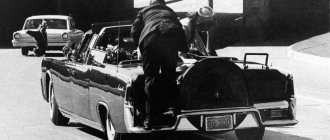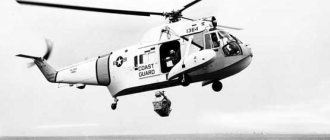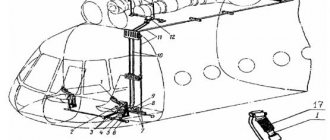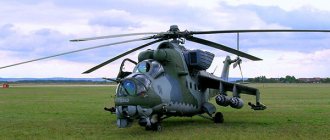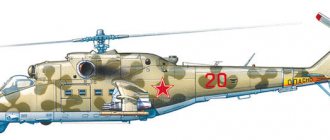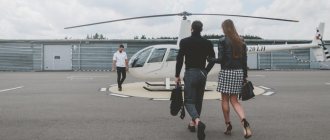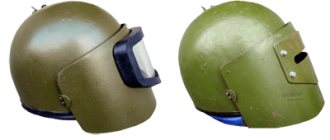Helicopter manufacturing began to develop dynamically after World War II. It quickly became clear that flying cars with propellers could be of great benefit in the economy and in war.
In the Soviet Union, when it came to designing helicopters, they not only kept up with the rest of the world, but even set the trend in some issues. Over half a century, a huge number of cars were made. Let's look at the most interesting of those that today it is almost impossible to see.
Additional sources:
- Lomonosov helicopter https://avia.pro/blog/vertolet-lomonosova
- Yuryev's swashplate https://www.youtube.com/watch?v=dtabeHixJUA
- Helicopter flight dynamics https://dcs-docs.lordvesel.win/ru/mi8/03.dynamic/
- History and design of the helicopter https://sitekid.ru/izobreteniya_i_tehnika/aviaciya/vertolety.html
- Soviet “heavyweight” Mi-26. Unique propeller https://topwar.ru/156964-sovetskij-supertjazh-mi-26-chast-2.html
- History of helicopters. Episode 1
- History of helicopters. Episode 2
- History of helicopters. Episode 3
- History of helicopters. Episode 4
First scientific research
In the 70s of the 19th century, the Russian scientist and academician Mikhail Rykachev (1840 - 1919) conducted many experiments. He designed a stand to test the properties of the main rotor and the developed lift force.
Mikhail Rykachev and his stand
Rykachev established that the lifting force depends not only on the speed of rotation of the blades, but also on the angle of installation of the blades relative to the longitudinal axis - the pitch of the propeller. As the pitch increases, the lift force increases.
Screw pitch
Rykachev also concluded that to control a helicopter, you need to tilt the plane of rotation of the propeller. Part of the force created by the rotation of the blades will go not only upward, but also horizontally. Rogachev's research became the basis for helicopter control systems.
Scientific research on the topic of vertical take-off machines was also carried out in the West - in France, Germany, the USA, and Great Britain.
Boris Yuryev's swashplate
Helicopters needed more efficient solutions to flight control problems. Back in 1911, the original idea of flight control was proposed by Boris Yuryev (1889 - 1957), a future Soviet academician, the founder of Soviet helicopter engineering, a student of the founder of hydro- and aerodynamics Nikolai Zhukovsky, and then a student at the Moscow Imperial Technical School. Yuriev became one of the first in the world to come to this principle of management.
Boris Yuriev and the swashplate
Yuryev called his invention a swashplate . According to Yuryev’s idea, the pitch of each blade as they moved in a circular motion was supposed to change cyclically using a special mechanism. To move forward, you had to tilt the helicopter forward. To do this, the pitch of the blade in the rear part of the propeller was increased using a swashplate, and in the front part it was decreased. You could move sideways in the same way.
Flight control using swashplate
Today, the swashplate is used on helicopters of all types and is recognized as the most effective.
Ideas for vertical take-off machines
Helicopter Leonardo da Vinci
The idea of a vertically taking off vehicle in the 15th century was proposed by Leonardo da Vinci, an Italian artist, scientist, inventor, and the largest representative of the art of the High Renaissance. As a basis, he took the Archimedes screw, under which a cradle with people was attached. People had to move in a circle and spin the screw. It should be noted that most of da Vinci's drawings remained on paper.
Helicopter Leonardo da Vinci
Aerodrome machine Lomonosov
In the 18th century, the first Russian scientist and academician Mikhail Lomonosov proposed building a vertically taking off apparatus to study the atmosphere. The device was supposed to lift instruments - for example, a thermometer. A description of such a device by Lomonosov has reached us, but no drawings remain.
It is known that the two screws were supposed to rotate with the help of cocked clock springs. It was found that Lomonosov's apparatus could lift 10 grams of weight. Lomonosov understood that stronger springs were needed, but they would also weigh more. Those. Initially it all came down to the lack of a suitable engine.
Aerodrome machine Lomonosov
The minutes of the academy dated July 1, 1754 record:
“The venerable adviser Lomonosov showed a machine he had invented, which he called an aerodrome (air-running) machine, which should be used in order to press the air (throw it down) with the help of wings moved horizontally in different directions by the force of a spring, which is usually supplied to watches. ), causing the machine to rise into the upper layers of air, so that the conditions (state) of the upper air can be examined using meteorological machines (instruments) attached to this aerodrome machine. The machine was suspended on a cord stretched across two blocks and kept in balance by weights suspended from the opposite end. As soon as the spring was wound up, [the machine] rose in height and therefore promised to achieve the desired effect.”
Feather helicopter
The first working model of a “helicopter” is recognized as the invention of the French – the naturalist Launois and the mechanical physicist Bienvenu. They presented the device in 1784 at the Paris Academy of Sciences. Two feather screws rotated under the action of an elastically twisted bowstring.
Helicopter Launois and Bienvenu
The 19th century did not provide a significant breakthrough in helicopter engineering. Only at the beginning of the 20th century a technical revolution occurred - a fairly light and powerful internal combustion engine appeared. From now on, a new era began in the history of the conquest of the sky.
The first helicopter testers encountered a lot of problems. The lift created by the propellers was directed strictly upward. How to control the plane and move left, right, forward and backward?
The first helicopters with controlled horizontal flight
Henry Berliner's helicopter
In 1922, the American Henry Berliner proposed an original idea - on the sides of the fighter fuselage there were two propellers on a transverse beam, pointing upward. There was another small propeller in the tail, which deflected the helicopter fuselage in pitch (back and forth), creating the necessary force for horizontal movement. As test flights showed, such a helicopter had poor control and was unstable in flight.
Henry Berliner's helicopter
Helicopter of George Botezat
Around these years, the Russian-American scientist, mathematician and inventor Georgy Botezat (1882-1940), who emigrated to the USA, proposed his solution to the management problem.
He created a “quadcopter” - a helicopter with 4 rotors. By adjusting the pitch of each of the 4 propellers, it was possible to control horizontal flight. But the design turned out to be bulky and heavy. Botezat managed to fly 4 meters and stay in the air for about 2 minutes.
Botezata helicopter with 4 propellers. 1922
The first helicopter with swashplate
Due to a lack of funding, leadership in the use of swashplates passed to the Argentinean Raul Pescara (1890-1966), who first launched his helicopter in 1921 in Spain. It was a helicopter with two coaxial rotors rotating in different directions. A number of world records were set on it - flying at a speed of 8 km/h to a distance of 1000 meters.
Model of Raoul Pescara's 4S coaxial helicopter, 1931
The first Soviet helicopter
At TsAGI (Zhukovsky Central Aerohydrodynamic Institute - founded in 1918), a helicopter group was formed in 1926 and a special stand was built to study the dynamics of the main rotor, the aerodynamics of the blades, and the properties of the engine transmission. At TsAGI, issues of strength and swashplate were resolved.
Helicopter with one main rotor TsAGI-1 EA
In August 1930, under the leadership of Alexey Cheryomukhin (1895 - 1958), an experimental device was built - a single-rotor helicopter TsAGI-1-EA. It was a revolutionary decision.
Even at the dawn of helicopter manufacturing, they came to the conclusion that if there is only one propeller, then the aircraft itself will rotate in the opposite direction - according to Newton’s third law, “action is equal to reaction.” Therefore, all helicopters before had an even number of propellers - half rotated in one direction, half in the other. Helicopters with 2, 4, 6 and even 8 screws were created. There were helicopters with a coaxial design, when two rotors rotating in the opposite direction were on the same axis.
Back in 1911, Boris Yuryev proposed a design with one main rotor. To prevent the car from rotating in the direction opposite to the propeller, a tail rotor was needed in the tail.
Aircraft designer Alexey Cheryomukhin (1895 - 1958)
Testing of such a single-rotor helicopter began many years later - in the fall of 1930. True, TsAGI-1 had not one, but 4 tail rotors - two at the front and two at the rear. The permanent tester of this helicopter was its designer, Alexey Cheremukhin (a participant in the First World War and a fighter pilot).
Helicopter TsAGI-1 EA
On August 16, 1932, Cheryomukhin lifted a single-rotor TsAGI-1 helicopter to a height of 605 meters and broke the world record of the Italian D'Ascanio by as much as 34 times.
The late 1930s and 40s became very difficult for helicopter manufacturing in the USSR. First - arrests and disbandment of the group at TsAGI, then war. But despite everything, Soviet engineering and scientific thought snatched the palm in helicopter construction. And this happened already in the early 50s of the 20th century.
For some time the Germans come forward, and then the Americans with helicopters of the Russian emigrant to the USA Igor Sikorsky (1889 - 1972).
Sikorsky on the covers of American magazines. Photo: warspot.ru

